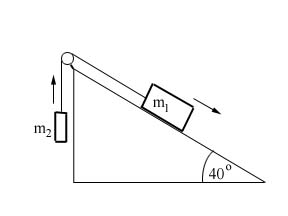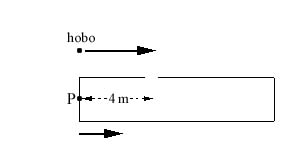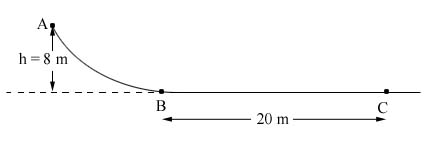
2. Do parts A and B.
Answers will be found at the following link.
Show all work. Part credit will be given in all problems.
Do FOUR of the five problems.
1. In the figure below, m1 = 10 kg,
m2 = 2 kg. The coefficient of friction,
m = 0.35. It is given that m1 slides down the slope, and m2 moves up.
a) Calculate the normal force that acts on m1
b) Calculate the friction force that acts on m1.
c) Write an equation for the acceleration of m1.
d) Write an equation for the acceleration of m2.
e) Find the acceleration of the two bodies, and the tension in the string.

2. Do parts A and B.
A. The figure below shows two vectors, P and Q. Assume the magnitude of Q is two units. Without using a ruler or protractor, draw an approximate diagram showing the vectors P and Q, and the vector R = P - 2Q. Make an estimate of the magnitude of R and its direction (by giving an approximate angle from north, east, west, or south).

B. A ball is thrown down at 1.5 m/s and after 0.1 s its speed is 2.48 m/s. Now suppose the ball is thrown upward with a speed of 2.48 m/s. What can you predict about its future motion from time reversal invariance, assuming you do not know anything else about the kinematics or dynamics of motion under gravity.
3. A hobo is trying to hop on a moving freight car. He runs at constant speed = 3.0 m/s. At the instant that he passes the back of the car (point P) the train is moving at 1.0 m/s and has a constant acceleration of 0.4 m/s2. The open door of the car is 4.0 m from P.
a) Write an equation for the displacement of the hobo as a function of time.
b) Write an equation for the displacement of the back of the car as a function of time.
c) Will the hobo be able to get on the train? How much time does it take for him to reach the open door?
d) What is the speed of the train at this time?

4. A stone is thrown from the roof of a building at speed = 15 m/s and in a direction 30 degrees above the horizontal. It hits the ground in 3.2 seconds.
a) Find the components of its initial velocity.
b) How high is the building?
c) How far from the foot of the building
does the stone land.?

5. A child on a sled (total mass = 80 kg) slides down an icy (frictionless) slope. (Height h as shown in the diagram.) She gets a running start, and is moving at 2.0 m/s at the top of the slope (point A). When she gets to the bottom (point B) her speed is V. She then slides on level snow (from B to C), where there is a coefficient of friction, m. She comes to a stop after 20 meters on the level ground.
a) Find the total energy at the top of the slope.
b) Find V.
c) Find the work done by friction.
d) Find m.
